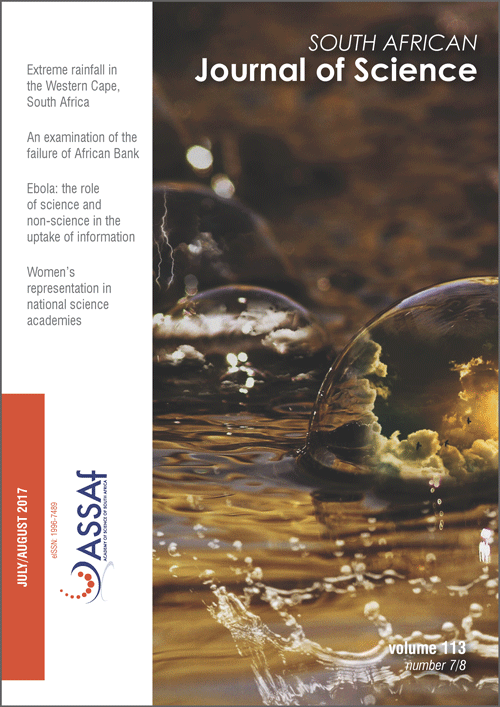Extreme 1-day rainfall distributions: Analysing change in the Western Cape
DOI:
https://doi.org/10.17159/sajs.2017/20160301Keywords:
extreme rainfall, stationarity, hazard, climate, generalised Pareto distributionAbstract
Severe floods in the Western Cape Province of South Africa have caused significant damage to property and infrastructure over the past decade (2003–2014). The hydrological design criteria for exposed structures and design flood calculations are based mostly on the implicit assumption of stationarity, which holds that natural systems vary within an envelope of variability that does not change with time. This assumption was tested by examining the changes in extreme 1-day rainfall high percentiles (95th and 98th) and both the 20- and 50-year return period rainfall, comparing the period 1950–1979 against that of 1980–2009 across the province. A generalised Pareto distribution and a peaks-over-threshold sampling approach was applied to 76 rainfall stations across the province. Of these stations, 48 (63%) showed an increase in the 50-year return period 1-day rainfall and 28 (37%) showed a decrease in the 1980–2009 period at the 95th percentile peaks-over-threshold. At the 98th percentile peaks-over-threshold, 49 stations (64%) observed an increase and 27 (36%) a decrease for the later period. The change in the number of 3-day storms from the first to the second period is negligible, evaluated at 0.9% and 0.5% at the 95th and 98th percentile peaks-over-threshold levels, using cluster analysis. While there is no clear spatial coherency to the results, the general trend indicates an increase in frequency of intense rainfalls in the latter half of the 20th and early 21st centuries. These results bring into question assumptions of stationarity commonly used in design rainfall.
Significance:- 63% of analysed rainfall stations in the Western Cape display an increase in 20- and 50-year 1-day rainfall extremes.
- The results challenge the current assumptions of climate stationarity made in design rainfall estimations.
- We propose an alternative methodology to rainfall extremes analysis for design flood estimation.
- The methods employed can be replicated by future studies in other regions.
Published
Issue
Section
License

All articles are published under a Creative Commons Attribution 4.0 International Licence
Copyright is retained by the authors. Readers are welcome to reproduce, share and adapt the content without permission provided the source is attributed.
Disclaimer: The publisher and editors accept no responsibility for statements made by the authors
How to Cite
- Abstract 793
- PDF 1308
- EPUB 209
- XML 262













.png)